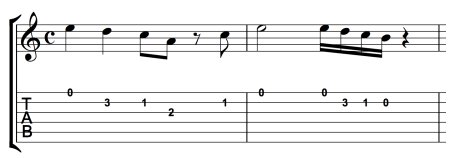
Tab
Most guitar players learn using “tab”, which is short for Tablature. If you play the guitar, you have probably used tab. Tab looks like this:

However, you have probably also seen music written a different way, with dots and squiggly lines; this is called “notation”. It is a universal method of writing music – anyone can read the same piece of music notation on any instrument as long as they know where the notes are. Notation looks like this:

Tab is specific to the guitar. The lines in tab represent the strings and the numbers written on the lines represent the frets that you play. The benefit of tab is that it’s VERY easy and quick to learn. If you are a beginner guitarist then it will help you start playing music very quickly. However, there are some downsides:
Notation
Notation is music written on a “stave” or “staff”, which consists of 5 lines and a “clef” sign which tell you what notes the lines represent. Here is a stave with a treble clef, which is the sign you would see for guitar music:

This means the lines, from the bottom up to the top, represent the notes
E G B D F
An easy way to remember this is: Every Good Boy Deserves Fruit
The spaces in between the lines, from the bottom space to the top, represent the letters that spell out the word “face”.
F A C E
This is how you can find the notes easily on the stave.
When should you learn to read notation?
I would recommend that you do not learn to read music notation until you have already been playing for a year or so. You should start off by learning to play songs and scales from tab. Later on you need to learn the notes on the fretboard off by heart; a good guitar teacher will show you easy ways of doing this.
Once you know where the notes are, you can learn to read notation by first learning where the notes are represented on the stave, and then learning how the different rhythms are notated. In the example above, you can see different rhythms notated by some notes being joined by a beam, or some notes having a squiggly tail, or some notes having a double beam. These mean some notes are faster than others. It is a very precise method of writing down the rhythm of a melody, and it is one of the MAJOR advantages of notation over tab. When you can read music notation reasonably well, you can take a quick look at a piece of music and then play it, making it sound EXACTLY the way the composer intended it to sound. That is almost impossible with tab.
Conclusion
These days, good tab is often accompanied by music notation, which looks like this:

Or sometimes you would see a hybrid kind of tab, which has the rhythms of notation drawn in over the tab, like this:

But this is still not ideal as it’s impossible to tell in some cases whether a note is supposed to last for one or two beats.
In conclusion, a serious guitarist should definitely learn both systems after the beginner stage of playing.
And if you intend to write music, it is ESSENTIAL to learn music notation. It is actually very hard to write a melody in tab, and in comparison, easy to write one in notation! Another MASSIVE benefit of writing in notation is that it is very quick, simple and easy to see what notes are in any triadic or 7th chord almost immediately.
Find a great guitar teacher in your area to help you learn to read notation as well as tab! If you are in Dublin, Ireland check out the best guitar lessons in Dublin.